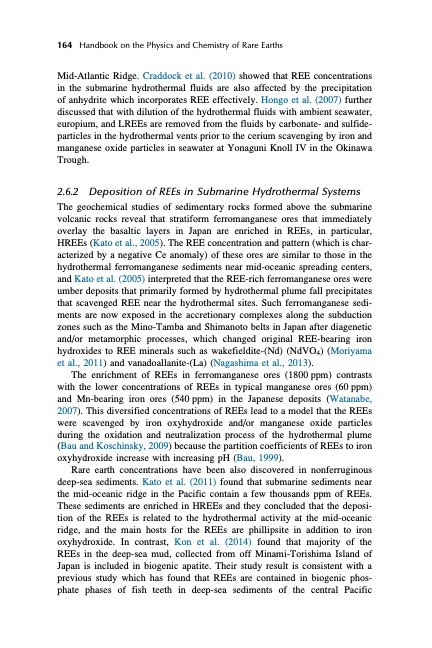
PDF Publication Title:
Text from PDF Page: 200
164 Handbook on the Physics and Chemistry of Rare Earths Mid-Atlantic Ridge. Craddock et al. (2010) showed that REE concentrations in the submarine hydrothermal fluids are also affected by the precipitation of anhydrite which incorporates REE effectively. Hongo et al. (2007) further discussed that with dilution of the hydrothermal fluids with ambient seawater, europium, and LREEs are removed from the fluids by carbonate- and sulfide- particles in the hydrothermal vents prior to the cerium scavenging by iron and manganese oxide particles in seawater at Yonaguni Knoll IV in the Okinawa Trough. 2.6.2 Deposition of REEs in Submarine Hydrothermal Systems The geochemical studies of sedimentary rocks formed above the submarine volcanic rocks reveal that stratiform ferromanganese ores that immediately overlay the basaltic layers in Japan are enriched in REEs, in particular, HREEs (Kato et al., 2005). The REE concentration and pattern (which is char- acterized by a negative Ce anomaly) of these ores are similar to those in the hydrothermal ferromanganese sediments near mid-oceanic spreading centers, and Kato et al. (2005) interpreted that the REE-rich ferromanganese ores were umber deposits that primarily formed by hydrothermal plume fall precipitates that scavenged REE near the hydrothermal sites. Such ferromanganese sedi- ments are now exposed in the accretionary complexes along the subduction zones such as the Mino-Tamba and Shimanoto belts in Japan after diagenetic and/or metamorphic processes, which changed original REE-bearing iron hydroxides to REE minerals such as wakefieldite-(Nd) (NdVO4) (Moriyama et al., 2011) and vanadoallanite-(La) (Nagashima et al., 2013). The enrichment of REEs in ferromanganese ores (1800 ppm) contrasts with the lower concentrations of REEs in typical manganese ores (60 ppm) and Mn-bearing iron ores (540 ppm) in the Japanese deposits (Watanabe, 2007). This diversified concentrations of REEs lead to a model that the REEs were scavenged by iron oxyhydroxide and/or manganese oxide particles during the oxidation and neutralization process of the hydrothermal plume (Bau and Koschinsky, 2009) because the partition coefficients of REEs to iron oxyhydroxide increase with increasing pH (Bau, 1999). Rare earth concentrations have been also discovered in nonferruginous deep-sea sediments. Kato et al. (2011) found that submarine sediments near the mid-oceanic ridge in the Pacific contain a few thousands ppm of REEs. These sediments are enriched in HREEs and they concluded that the deposi- tion of the REEs is related to the hydrothermal activity at the mid-oceanic ridge, and the main hosts for the REEs are phillipsite in addition to iron oxyhydroxide. In contrast, Kon et al. (2014) found that majority of the REEs in the deep-sea mud, collected from off Minami-Torishima Island of Japan is included in biogenic apatite. Their study result is consistent with a previous study which has found that REEs are contained in biogenic phos- phate phases of fish teeth in deep-sea sediments of the central PacificPDF Image | HANDBOOK ON THE PHYSICS AND CHEMISTRY OF RARE EARTHS

PDF Search Title:
HANDBOOK ON THE PHYSICS AND CHEMISTRY OF RARE EARTHSOriginal File Name Searched:
Chemistry-Rare-Earths-49.pdfDIY PDF Search: Google It | Yahoo | Bing
Sulfur Deposition on Carbon Nanofibers using Supercritical CO2 Sulfur Deposition on Carbon Nanofibers using Supercritical CO2. Gamma sulfur also known as mother of pearl sulfur and nacreous sulfur... More Info
CO2 Organic Rankine Cycle Experimenter Platform The supercritical CO2 phase change system is both a heat pump and organic rankine cycle which can be used for those purposes and as a supercritical extractor for advanced subcritical and supercritical extraction technology. Uses include producing nanoparticles, precious metal CO2 extraction, lithium battery recycling, and other applications... More Info
| CONTACT TEL: 608-238-6001 Email: greg@infinityturbine.com | RSS | AMP |